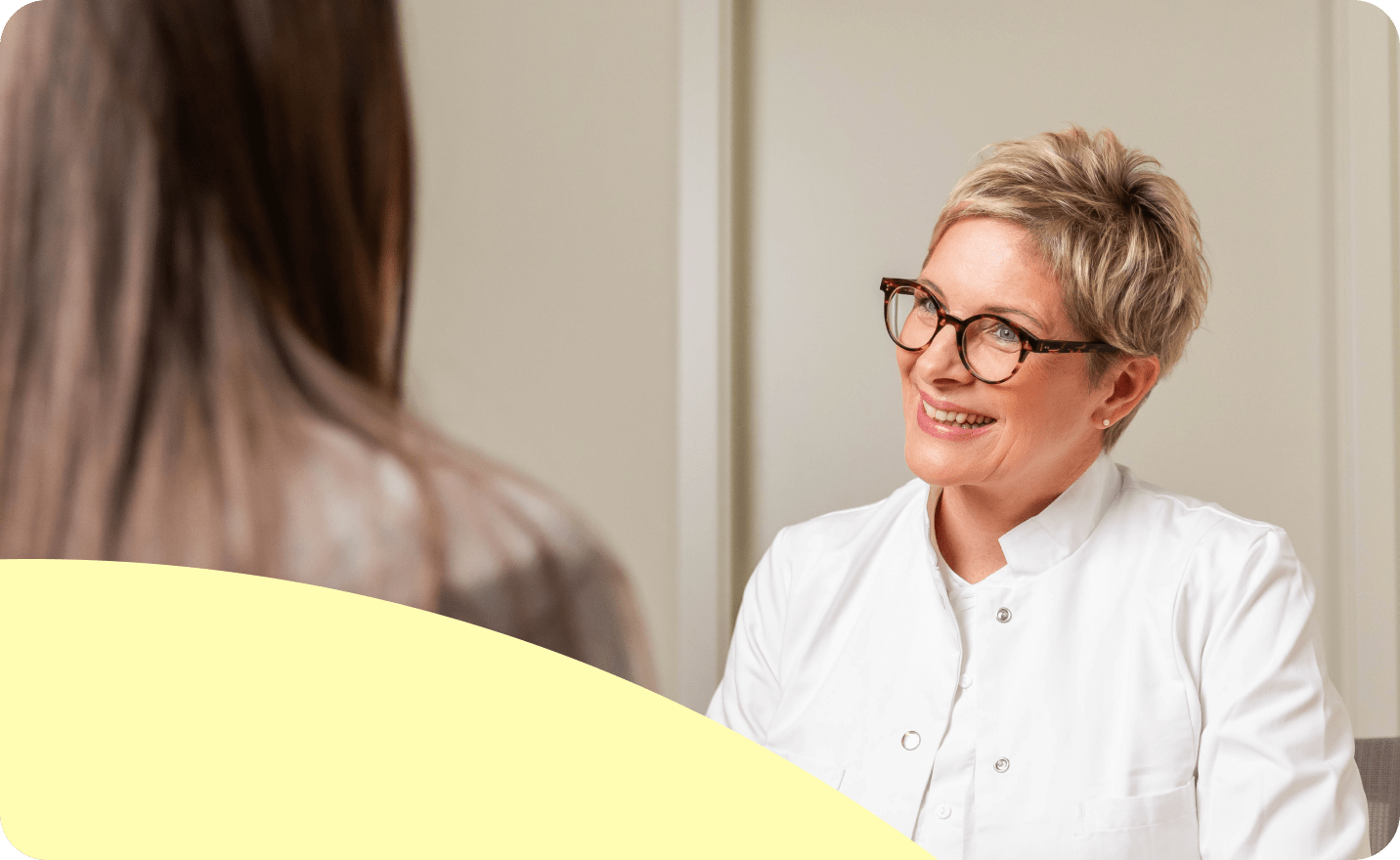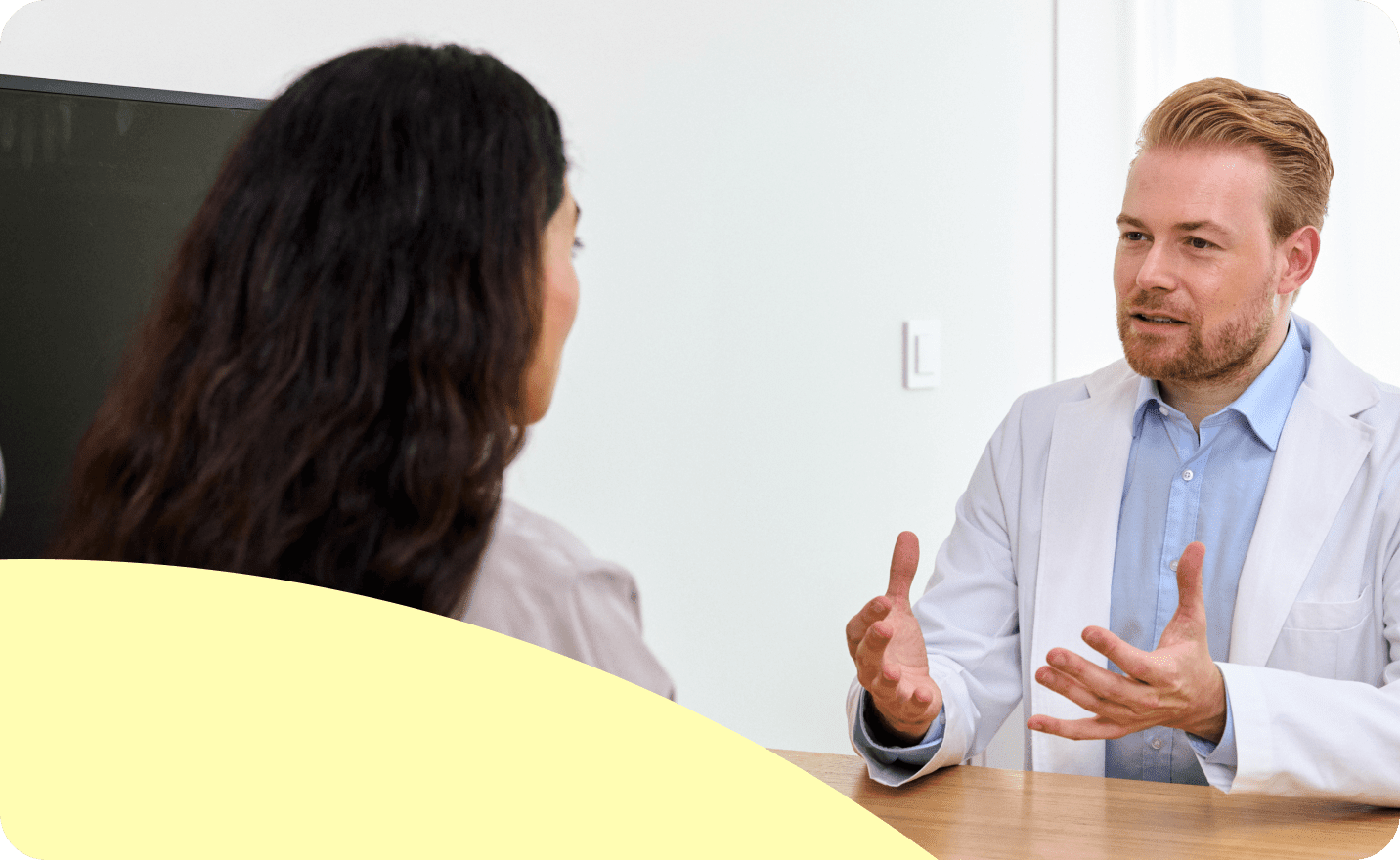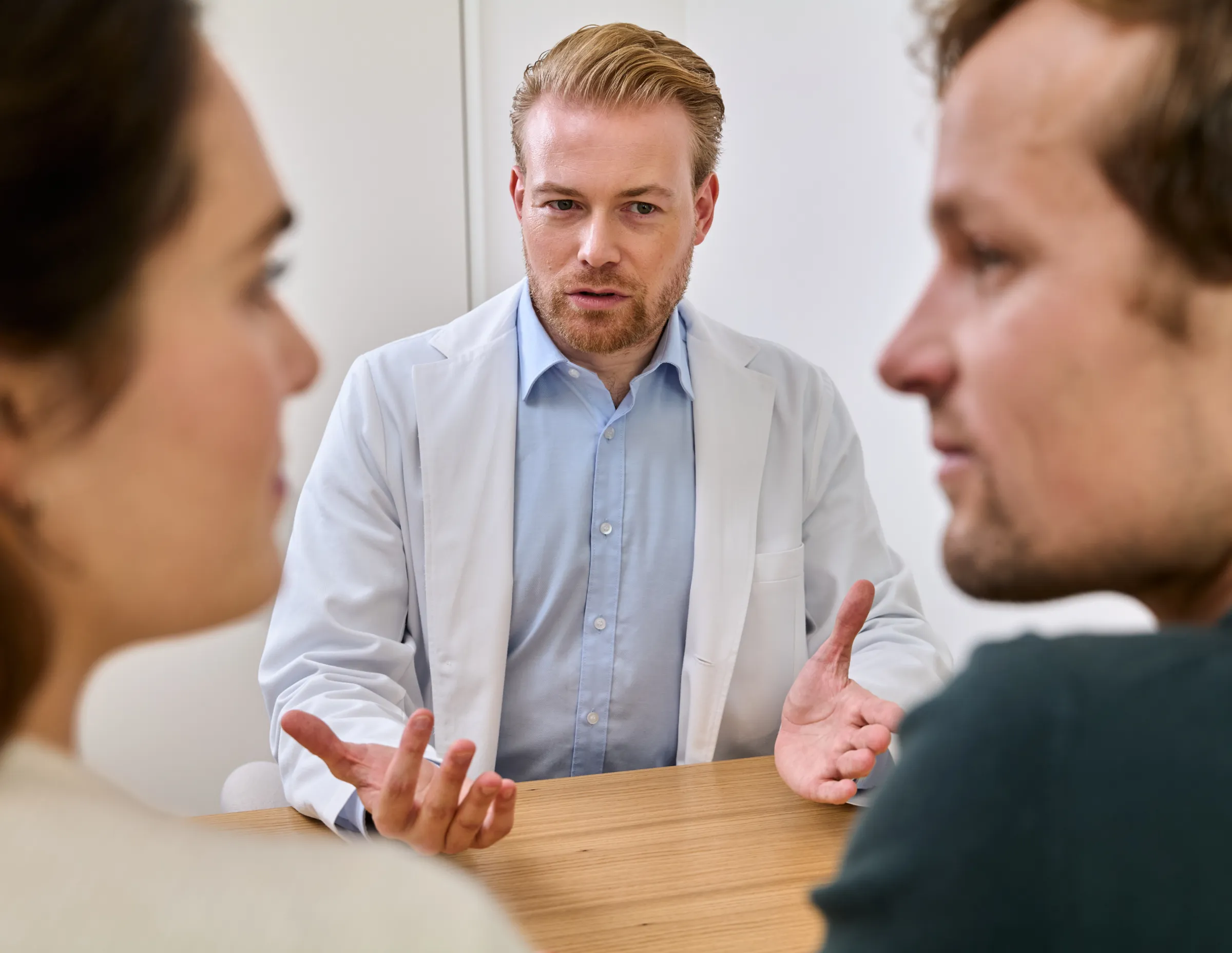What is ovulation and why is it important? Learn about how to calculate your fertile window and improve your chances of conceiving.
How many days after my period does ovulation occur? Can you get pregnant after ovulation? How long does ovulation last? Can calculating ovulation be used as a means of contraception?
The day of ovulation is of central importance for conceiving a child naturally. The fertile window, i.e. the period during which a woman can become pregnant, lasts only six days per cycle. This makes it all the more important for individuals and couples who want to have children to have sexual intercourse in the days around ovulation. In this article, we explain how you can calculate, measure and observe your own ovulation.
What is ovulation?
Ovulation is a process during the female cycle when at least one mature egg (ovum) is released into the fallopian tube. The egg is first found in a follicle (egg sac), several of which mature per cycle in the two ovaries. Usually, only one ovum makes it through the full maturation process. It then ‘jumps’ from the ovary into the fallopian tube during ovulation.
In rare cases, several make it and are released into the fallopian tube together. In such cases, unprotected intercourse could result in a multiple pregnancy. Whether the egg is delivered into the right or left fallopian tube is a matter of chance.
How often does ovulation occur?
In women who do not use hormonal contraception, ovulation occurs once per menstrual cycle. The average length of the cycle is approximately 28 days. However, the number of days varies from woman to woman. Some women have a shorter cycle, others a longer one. Differences from cycle to cycle are also possible. For example, your cycle may be 26 days one month and 33 days the next, and so on. Ovulation occurs around the middle of the cycle, 14 days before the next period. But because cycle lengths can fluctuate so much, it is difficult for many women to know the exact day they ovulate.
It can also happen that ovulation does not occur. This is called an anovulation. Anovulation is especially common in young girls who have not had their periods for long, or women going through menopause. However, anovulation can also occur after puberty, or before menopause. This may be due to a hormonal disorder, such as polycystic ovary syndrome (PCOS). The absence of ovulation often goes unnoticed because some women still get their period. This type of menstruation is called breakthrough bleeding. It results from a decreased concentration of the hormones estrogen and progesterone.
How long does ovulation last?
The bursting of the follicle in the ovary and the passage of the egg into the fallopian tube last only a short time. Once the egg is in the fallopian tube, it can be fertilised for between 12 and 24 hours. Sperm cells can survive up to 5 days after ejaculation. For this reason, there is considered to be a fertile window of 6 days in total per cycle. The chances of conceiving are greatest if a couple has unprotected sex during this time.
If fertilisation does not occur after ovulation, the egg disintegrates and is reabsorbed by the body. The follicle forms into a corpus luteum, which is a temporary gland that produces progesterone and estrogen to prepare the uterine lining for the possible implantation of a fertilised egg. If fertilisation does not occur, progesterone and estrogen levels decrease again and the menstrual period begins.
How to calculate your ovulation
You can calculate your ovulation yourself or use a fertility calculator (or cycle calculator) online. The advantage of an online fertility calculator is that your ovulation calendar is displayed with approximate day of ovulation as well as ovulation window.
Calculation for irregular cycle
Regardless of whether you want to perform the calculation yourself or use a cycle calculator, you need to know your average cycle length. Calculating this is a bit more complex if you have irregular periods, meaning that the length of your menstrual cycle tends to vary. In this case, you can calculate an average cycle length.
To determine your average cycle length, make a note of the start of each of your periods over the next 3 to 12 months. The first day of your period corresponds to the first day of your cycle. This should be when your flow starts and not just spotting. If your next period begins 28 days after the start of your previous one, you calculate 28-1 (= 27). The first calculated cycle was therefore 27 days long. If you know the length of 3 to 12 cycles, you can add all cycle lengths and divide by the number of measured cycles. This is how you calculate the average cycle length.
You can also use free apps to record the dates of your periods.
Once you know your average cycle length, you can use the calendar method, also known as the Knaus-Ogino method, to calculate your ovulation.
For this method, you take the shortest of the calculated cycle lengths (assuming 27 days) and subtract 18 days from it (= 9). Now you take the longest of the calculated cycle lengths (assumed 32 days) and subtract 11 days from it (= 21). According to the calendar method, your ovulation window is approximately between the 9th and 21st day of your cycle.
Calculation for a regular cycle
If your menstrual cycle is always the same length (for example, always 30 days), then you have a regular cycle. This increases the accuracy of the calculation of your next ovulation, since ovulation always occurs two weeks before menstruation. To calculate the day of ovulation itself, take the day when your next period should start and subtract 14 days (e.g. 30-14 = 16).
Online fertility calculators are also suitable for regular cycles. You enter the day of your last period and the length of your cycle. Some fertility calculators even calculate the approximate date of birth if conception was successful.
Why ovulation calculators are not suitable for contraception
You can find numerous ovulation calculators on the Internet that use your cycle length to calculate the next ovulation day or the next ovulation window. These calculators should not be used as birth control, as the hormones that control your cycle can quickly become unbalanced. Calculators are based on mathematical formulas and do not take into account such personal cycle fluctuations. Instead, ovulation calculators are especially suitable for those who wish to have children.
In addition to calculations, ovulation can be observed or measured based on physical changes.
Are there signs of ovulation?
Some women feel a pulling sensation on one side of the abdomen during ovulation. This pain is also called mittelschmerz (a German term meaning ‘middle pain’). Exactly what triggers the pain has not been definitively determined. It could be caused by the bursting of the follicle, the swelling of the ovaries due to the maturing follicle, or the contractions of the fallopian tubes that transport the egg toward the uterus.
Beyond that, ovulation is not felt. However, there are other physical signs that indicate ovulation.
How to recognize ovulation
In addition to the mittelschmerz, you can recognize ovulation by the following physical changes:
- Changed cervical mucus: Cervical mucus refers to the regular secretions of the cervix that pass through the vagina. During the menstrual cycle, this secretion changes in color and consistency. In the days around ovulation, cervical mucus is glassy and moist, similar to a raw egg white. It also increases in quantity.
- Soft cervix: Another sign that suggests ovulation is a soft cervix. When a woman is fertile, the cervix is soft and lies much higher in the vagina than during infertile days.
If you just stopped taking birth control, your cycle may be irregular for a few weeks or a couple months. It may therefore take a while before you notice that you are ovulating.
It is also possible to measure ovulation through
- Increased temperature: After ovulation, your body temperature increases by around 0.2–0.6 degrees Celsius. It is important in this method that women measure their body temperature right after waking up. This is also called the basal body temperature. Observing cervical mucus, measuring basal body temperature and palpating the cervix are methods of so-called natural family planning (NFP).
- Ovulation tests: These tests provide even more precise information about the time of your ovulation. You can get these tests at the pharmacy or order them online. For this test you should know your average cycle length. A pack contains several test strips that you use for a urine test every day from a certain day in the cycle, depending on your average cycle length. This measures the hormone levels of luteinizing hormone (LH), which triggers ovulation.
- Folliculometry: Gynaecologists can perform what is called folliculometry to determine ovulation. This is an ultrasound examination, measuring the size of the maturing follicle to predict when it will burst and release an egg. Folliculometry is not considered a health insurance benefit and therefore must be paid for privately.
Can you get pregnant without ovulation?
No, a woman cannot get pregnant without ovulation. For a pregnancy to occur, an egg must be fertilised by a sperm cell.
Anovulatory cycles are not uncommon. In fact, a Norwegian study observed a cycle of spontaneously menstruating women who were using non-hormonal contraceptive (meaning that it did not interfere with ovulation). The study found that 37 percent of participants did not ovulate. Anovulation is generally not a cause for concern. However, chronic anovulation can be a cause of unexplained infertility. Couples are considered infertile if the woman has not become pregnant despite regular and unprotected sexual intercourse for 12 months (or 6 months for those over 35).
When can I perform a pregnancy test?
If you have had unprotected sexual intercourse around the time of ovulation, it may take a while for the pregnancy test to show a result. This is because pregnant tests detect the hormone hCG, which is only produced once a fertilised egg travels to the uterus and successfully implants in the uterine lining. The steadily increasing hCG may be detected eight days after implantation at the earliest with at-home pregnancy tests.
The sensitivity of pregnancy tests varies depending on the brand. If you use the temperature method to calculate ovulation, you may also be able to detect you are pregnant by the fact that the temperature does not drop again after ovulation.
How soon after pregnancy will I ovulate again?
After the birth of a child, the body produces the hormone prolactin, which is responsible for milk production. This hormone usually inhibits ovulation. Some women use breastfeeding as a natural contraceptive method, also known as the lactational amenorrhea method. However, it is considered unreliable. If there is no specific desire to have more children, contraception should be used while breastfeeding.
Takeaway
Ovulation normally occurs once per cycle, but there are exceptions. For example, several follicles may release an egg into the fallopian tube. If unprotected intercourse occurs, this could result in a multiple pregnancy. Another exception is anovulation. In anovulatory cycles, ovulation fails to occur.
Once one or more eggs are in the fallopian tube, they can be fertilized within 12 to 24 hours. Couples who wish to have a child may have unprotected intercourse before ovulation, because sperm survive for several days in the woman's body. This is why we also speak of a fertile window, i.e. the fertile days in a woman's cycle.
Ovulation occurs around the middle of the cycle, but the length of the cycle varies from woman to woman. If you want to know the time of your ovulation, you should note down your cycle lengths and calculate your average cycle length. Afterwards, you can use an ovulation calculator online or the Knaus-Ogino method to calculate your fertile days. Since the cycle can quickly become unbalanced, you should never use ovulation calculations as a contraceptive method.
To complement the calculations, you can also look out for physical signs. A soft cervix, a slightly elevated basal body temperature, and runny, transparent cervical mucus are indicators of ovulation. The more often you pay attention to your body and its signs, the better you will become at noticing your ovulation. If you want absolute certainty about when you are ovulating, it is best to buy ovulation tests at the pharmacy or online, or make an appointment with your gynaecologist for folliculometry.
Do you want to get pregnant or expand your fertility awareness? Our empathetic specialists will help you determine your ovulation and ovulation window and advise you on all aspects of fertility. Reserve your spot for a personalised consultation today.







